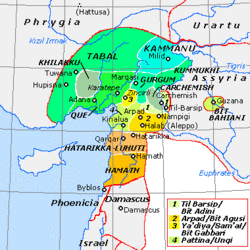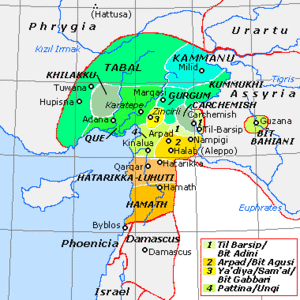Tunna or Dunna was an ancient Anatolian city located at the foothills of the Taurus Mountains, near the town of Ulukışla and the Cilician Gates in southern Cappadocia.

Arzawa was a region and political entity in Western Anatolia during the Late Bronze Age. In Hittite texts, the term is used to refer both to a particular kingdom and to a loose confederation of states. The chief Arzawan state, whose capital was at Apasa is often referred to as Arzawa Minor, while the other Arzawan kingdoms included Mira, Hapalla, Wilusa, and the Seha River Land.

Tabal, later reorganised into Bīt-Burutaš or Bīt-Paruta, was a Luwian-speaking Syro-Hittite state which existed in southeastern Anatolia in the Iron Age.

Tyana, earlier known as Tuwana during the Iron Age, and Tūwanuwa during the Bronze Age, was an ancient city in the Anatolian region of Cappadocia, in modern Kemerhisar, Niğde Province, Central Anatolia, Turkey.
Assuwa was a confederation of 22 states in western Anatolia around 1400 BC. The confederation formed to oppose the Hittite Empire, but was defeated under Tudhaliya I/II. The name was recorded in various centres in Mycenaean Greece as Asiwia, which later acquired the form Asia.
Salatiwara was a Middle Bronze Age city in south-central Anatolia on a road connecting the kingdoms Waḫšušana and Burushattum. The history of the city is known primarily from the Anitta text.

Kussara (Kuššar) was a Middle Bronze Age kingdom in Anatolia. The kingdom, though apparently important at one time, is mostly remembered today as the origin of the dynasty that would form the Old Hittite Kingdom.
The history of Anatolia can be roughly subdivided into: Prehistory of Anatolia, Ancient Anatolia, Classical Anatolia, Byzantine Anatolia, Ottoman Anatolia and the Modern Anatolia, since the creation of the Republic of Turkey.
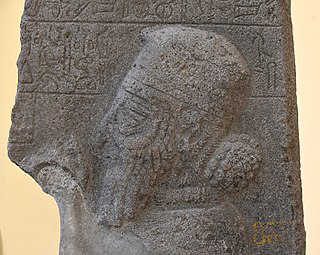
Warpalawas II was a Luwian king of the Syro-Hittite kingdom of Tuwana in the region of Tabal who reigned during the late 8th century BC, from around c. 740 to c. 705 BC.
Cybistra or Kybistra, earlier known as Ḫubišna, was a town of ancient Cappadocia or Cilicia.
Trevor Robert Bryce is an Australian Hittitologist specializing in ancient and classical Near-eastern history. He is semi-retired and lives in Brisbane.
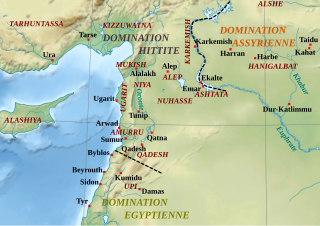
Nuhašše, was a region in northwestern Syria that flourished in the 2nd millennium BC. It was east of the Orontes River bordering Aleppo (northwest) and Qatna (south). It was a petty kingdom or federacy of principalities probably under a high king. Tell Khan Sheykhun has tenatively been identifed as kurnu-ḫa-šeki.
The Luwians were an ancient people in Anatolia who spoke the Luwian language. During the Bronze Age, Luwians formed part of the population of the Hittite Empire and adjoining states such as Kizzuwatna. During the Hittite New Kingdom, Luwian replaced Hittite as the empire's dominant language. In the early Iron Age, a number of Luwian-speaking Neo-Hittite states arose in northern Syria. The Luwians are known largely from their language, and it is unclear to what extent they formed a unified cultural or political group.
Ura was a very important port on the east Mediterranean coast of the southern Anatolia, in the Late Bronze Age and Iron Age, probably located at the site of modern Silifke, or further west of Gilindere.

Luhuti, Lukhuti or Lu'ash, was an Iron Age Syro-Hittite Aramean region during the early 1st millennium BC located in northern Syria, in an area that used to be called Nuhašše.

Zakkur was the ancient king of Hamath and Luhuti in Syria. He ruled around 785 BC. Most of the information about him comes from his basalt stele, known as the Stele of Zakkur.
The House of Suhi was a dynasty of rulers of Carchemish. The members of this dynasty are best known to us through Hieroglyphic Luwian sources. Only one member of the house of Suhi is specifically mentioned in Assyrian sources. The House of Suhi was followed by a dynasty known as the House of Astiruwa.

Hittite art was produced by the Hittite civilization in ancient Anatolia, in modern-day Turkey, and also stretching into Syria during the second millennium BCE from the nineteenth century up until the twelfth century BCE. This period falls under the Anatolian Bronze Age. It is characterized by a long tradition of canonized images and motifs rearranged, while still being recognizable, by artists to convey meaning to a largely illiterate population.
“Owing to the limited vocabulary of figural types [and motifs], invention for the Hittite artist usually was a matter of combining and manipulating the units to form more complex compositions"
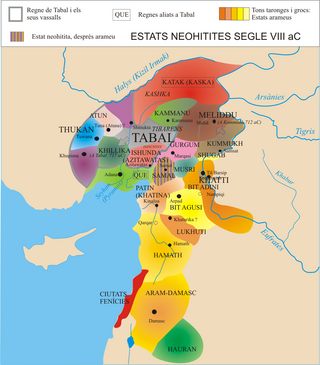
Ištuanda or Ištunda was a Luwian-speaking Syro-Hittite state which existed in the region of Tabal in southeastern Anatolia in the Iron Age.
